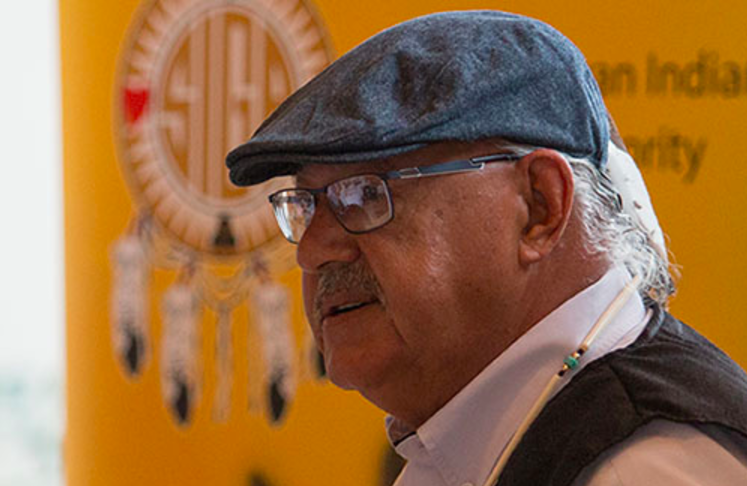Eugene Arcand: Is there anybody here?
Arcand’s words “underlines the need to help understand the impact of residential schools on Indigenous communities.”
By Kyrsten Stringer for Ink Online
“Good morning.”
Silence.
“Is there anybody in here?”
It’s a joke. The audience — a smorgasbord of journalists and representatives from Indigenous communities all over Saskatchewan — laughs. Some of them holler back.
The next thing Eugene Arcand does is speak in Cree. He explains afterwards that speaking this language — his language— is not something that he could have done twelve years ago.
Arcand is a residential school survivor, and the morning keynote for the Reconciliation and the Media conference, held from Oct. 4-5, 2016, designed to facilitate better understanding between journalists and Indigenous peoples in Saskatchewan.
Mixed into the audience are a dozen journalism students, including me. My assignment is to write a feature story —my first— about Eugene Arcand. For me there is something poetic about Arcand’s greeting and the way that it was received. The room was quiet. His question, “Is there anybody in here?” is designed to make people laugh, which it did; but it might also symbolize one of the hurdles at the root of the Truth and Reconciliation Commission’s calls to action. People have to sit up and listen, and then they have to respond.
When Arcand speaks the room is quiet. He is eloquent and dignified; masterful with the English language that was forced upon him when he was a little boy. He has come to talk about his childhood, and the role of residential schools as instruments of cultural genocide. His words are strong. His delivery is emotional and powerful.
Reconciliation and the Media co-chair Betty Ann Adam had heard Arcand speak earlier at a conference planning meeting.
“His words inspired us,” she says. “It underlines the need to help understand the impact of residential schools on Indigenous communities.”
Later, sitting with me at a table in the Gordon Oakes Red Bear Centre at the University of Saskatchewan, Arcand explains his decision to speak at conferences like Reconciliation and the Media. He says it is important to educate people. It is important for the media to learn how to help set the record straight on the subject of Canadian history, and how that history has impacted the lives of Canada’s Indigenous peoples.
“It’s a call to action for me to do what I do,” Arcand says. “It’s not only this conference. It’s whatever I can work into my schedule. As long as they follow my rules— that I don’t speak at night, and I won’t talk twice a day.”
Arcand doesn’t talk more than twice a day because it takes so much out of him to share details of his experiences with an entire room of people, most of them strangers. At the end of his speech, Arcand tries to get out of the room so that he can be alone with his emotions privately. His wife waits for him on the sidelines because she knows he needs her.
“Sometimes it’s okay,” he says, “ and sometimes it’s not. Because I go full out and it’s not me. I’m just a conduit to a message. I just go on a roll, and it’s from the heart. From my belief in the Creator to help me deliver a message on behalf of my schoolmates.”
Arcand carries a picture of his classmates from 1958. He shows it to me. The photograph is black and white, taken three weeks into the first September that Arcand spent as a residential school student. In the picture there are 32 children squeezed together in order to fit inside the camera frame. All of them small, all of them smiling, all of them with their hair recently cropped short. He points out a little boy named Robin Ermine, who was killed in his own living room in 1987, in what is still a Saskatoon cold case.
Arcand describes his previous experiences with the media as “not good.” He tells me a story about a reporter with whom he cut ties for breaking his trust, and with whom he reconciled at the conference that day.
“It’s sensationalising. It’s not understanding the souls and the spirits that walk the earth. Both missing and murdered Indigenous women, but mostly those 6,000 kids that never made it home. We don’t know where they are. We don’t know where they’re buried, and they [the reporter] didn’t take that as seriously as they should have.”
Arcand says this is why he was initially hesitant to speak with me, and why he asked me to wait before we sat down together. He wanted me to listen first. And so to his question “Is there anybody here?” I would like to say— I am.
This story was originally published on University of Regina’s Ink Online, and is republished here with the author’s permission.
Kyrsten Stringer is a freelance writer from Saskatchewan. Born and raised on the prairie, she has a BA in English from the University of Regina and is currently pursuing a Masters degree in Journalism.

